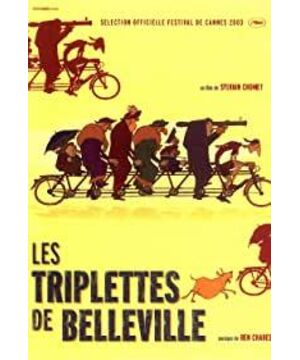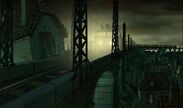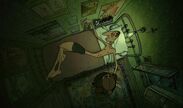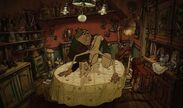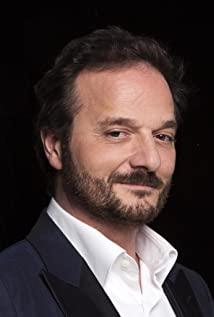French films always seem to have the tune of literary films, that kind of unique artistic expression, that kind of cultural analysis perspective, in my ordinary mind, it is really difficult to find appropriate words to describe, and it is impossible to use professional terms to explain.
When watching this film, I personally see two lines, one is the relationship between grandma and autistic grandson that we can naturally feel, and the other is the relationship between modern industrialization and materialized business era that I personally interpret. The terrible influence of the simple and pragmatic traditional society, the social criticism brought about by the continuous expansion of capitalism.
1.
Grandma and grandson watch the dance music of the three sisters on TV. The grandson always looks gloomy and unhappy. The patient and warm grandma tries to do many things for her grandson, but she still can't erase the top of her grandson's head. That dark cloud. With careful care and sensitive attention, the grandmother discovered her grandson's fondness for bicycles. So grandma began to take care of her grandson and train her grandson.
The image and character of the grandmother in the film may be exactly the tenacity, optimism, principled and appreciative national characteristics of the French nation that the director wants to express, and it may also project the fine and mellow French culture on the grandmother. Since I don't know much about French culture, I can only talk about some aspects in a limited way. But this grandma, from taking care of her grandson to training with her grandson, kept blowing the whistle to keep young people moving forward, and persevered diligently. This may also be a thematic intention of the director. No matter what the situation is, grandma is always calm and tactful. And the gritty image of grandma is also shown from the house that did not make way for the train track bridge (of course, this also has a satirical and bitter criticism of the modern industrial age)
In the film, the grandson is portrayed as a character with almost no emotion. Except for practicing bicycles, doing corresponding training, eating, sleeping, etc. according to his grandma's instructions, he rarely makes people feel his subjective wishes. Is the director's arrangement purely to express the autistic and confused teenager after losing his parents, or is he trying to portray contemporary French youth with the image of his grandson for ulterior motives? I'm not sure about this, but with the continuous expansion of the industrial age, the influence of the new era of materialism and cultural fast food on modern youth, many older generations are in a state of impetuousness, rapid changes, dwindling cultural heritage, fast food life. Contemporary young people, whose ways and values are increasingly corrupt, generally have a concern. So is Sun Tzu the epitome of the true face of contemporary French youth and even the contemporary youth of many capitalist countries?
The grandmother, who represents the rich history, rich culture and national tradition, cherishes the grandson who represents the deviated values, the increasingly materialized tendency, the mental impetuousness, and the more contempt for history, tradition and culture. This family line seems to be a metaphor for the care and guidance of the French elders to the younger generation of the French nation. No matter what alleys the French youth are captured and abducted by the material culture and commercial society, the French nation will do everything possible to save this generation of young people who are increasingly lost and blurred.
We can slowly teach you to experience the profound history, feel the rich culture, and learn the tenacity and uniqueness of national rejuvenation. There are some things that cannot be eroded from lifestyles, cultural fields, ideological trends, etc. by relying on the growing business. To destroy!
At the end of the story, the grandmother rescued the grandson, and the last sentence of the grandson ended calmly, which is the continuation of the grandmother's soul. This is the first time the grandson has spoken, and the grandson who is speaking at this moment is no longer the same as before. He seems to have inherited the French nation, history and culture represented by his grandmother.
In this film, the director and production team's intelligence and ingenious performance are astonishing.
At the beginning of the film, the cheerful rhythm is followed by a typical commercial cultural symbol representing entertainment enjoyment: signage, logo is a symbol, a unique cultural expression of commercial economy.
Then came the exaggerated high-rise building. Three sisters appeared in the subtitles. Everyone waited for the people in the car to come out as if they were welcoming superstars. Then three super fat rich women came out. Something like a handbag. But in fact, when the three sisters appeared in Gaoge, we discovered that these three fat and rich women were not stars, but spectators in the stands, and the stands were full of fat and rich women with similar differences. This performance directly satirizes the deviation of social value orientation in the business era, and people worship materialization and money very much. The three sisters are the ones who sing, but the rich but vulgar and fat ladies are favored by the stars.
As the entertainment and spiritual food of the rich in the materialized city, the three sisters will always perform on stage, but their living conditions have never been better. They were content to get applause, to live in squalid, poor rooms, and their kitchens had nothing but frogs from grenades. On the one hand, it reflects the contentment of the lower class with the status quo, and it also reflects the cold and numbness of the upper class.
This kind of technique can be seen everywhere in the film. Many cultural symbols, such as the shape of the bodyguard in black and the shape of the large ship, also have their meanings. In the end, it is from the weak support of the cultural foundation. The terrifying material world is still a metaphor for the uneven distribution of resources between the bottom class and the top class from the perspective of social class.
There is one thing I want to say. Although there are various metaphors, innuendos, and criticisms about culture, economy, human nature, etc. everywhere in this film, not every shot has a special meaning. After all, an animation also needs Going the plot, it still requires the screenwriter, director, and creative staff to arrange ingenious plots together. For example, the grandmother rescues the grandson in the back, and the big boss constantly sends killers to hunt down. The destruction of the car to continuously reduce the number of killers is more based on the smoothness of the plot and the natural and logical consideration of the handling method, rather than too much meaning and innuendo.
The Second Hidden Line: A Deconstruction and Criticism of the Capitalist Economy Since the Industrial Age
This line is hidden in the main storyline of grandma saving grandson. The clarity of the line is from the house in the suburbs where the grandma is in the shot, to the growing number of houses, the chimneys, and then the train tracks coming over the grandma's head. The color tone of the picture has gradually become colder from the previous warm tone. The arrival of the industrial age has not only disturbed the original tranquility, but also brought a broader and boundless silence.
Because the dog was overwhelmed by the model train when he was a child, the model train has always left a shadow in his mind. When the time comes every day, he always has to go up to bark a few words, like a protest against the ruthless industrial age.
The French Tour de France kicked off, and people joined in happily and enthusiastically. What is shown at this moment is a lively French face, people are laughing, families are warm, and various miniatures of French people's daily life are presented here one by one, and the cyclists are constantly climbing mountains and striving to move forward. It is the French nation's efforts A symbol of the game, the game alludes to the state of society in France before capitalism took over the world. But then things start to happen, the grandson of bike number 69 is kidnapped, and the grandma and the dog start their journey to find him.
Why use the Statue of Liberty and the big ferry, the exaggerated New York City skyscrapers as symbols of the capitalist business era? I don’t think the French would want to use Paris, the French metropolis, as a blueprint. Second, considering the rise of capitalism and the center and leader of the global business economy are the United States, the birth of the glorious era of capitalism is closely related to the impact of the American economy and the United States. Status is closely related, so it is not unreasonable to direct criticism to New York City.
After arriving in New York City, there is a scene that is particularly easy to ignore. The beggar is wearing the No. 69 jersey. This scene is a satire of the capitalist business era, in which industrious people eventually become beggars, and the ugly, vulgar and People who have no connotation and are cold-blooded and cruel are sitting on countless assets and enjoying superior social resources.
After that, the grandson and two other racers were riding bicycles, running in front of the illusory screen, losing French wine in their hands. This paragraph is a metaphor: capitalism's ruthless exploitation and mental paralysis of low-class people gives you a false future and an illusion of progress, allowing you to work in a position of being exploited.
After this scene, the dog dreamed that its owner was pulling the train and was walking on the rails with difficulty. When the camera continued to zoom out, we found that it was a box containing dog food. This kind of perpetual rushing work revolves around food! This scene is to imply that most of the capitalist exploited classes live a lifetime of hardship but can only make a living forever, and their whole life labor is fought hard around the sad 'dog food'. This is the culmination of the inequitable distribution within the capitalist society and the innuendo to the lower classes of the bourgeoisie.
I think I’ll talk about these things. I have to marvel at the thinking of the French people. At the same time, I am very grateful to those human beings in the world who insist on artistic creation and bring us more masterpieces, wider perspectives and alternative thinking angles.
View more about The Triplets of Belleville reviews


